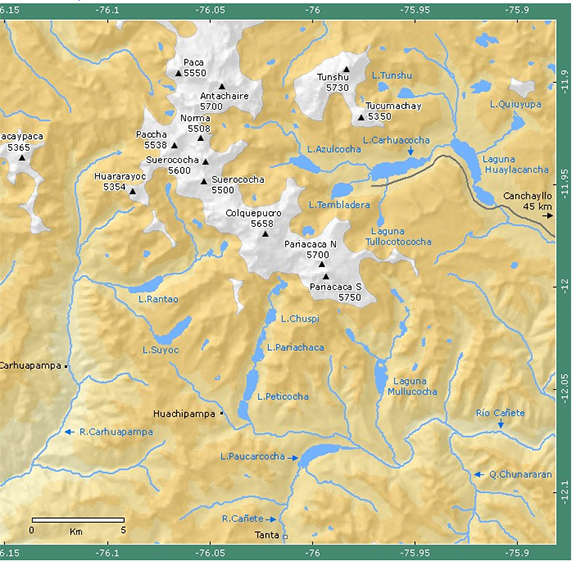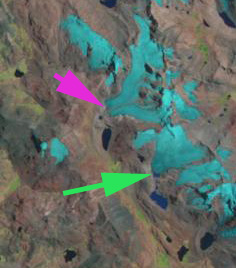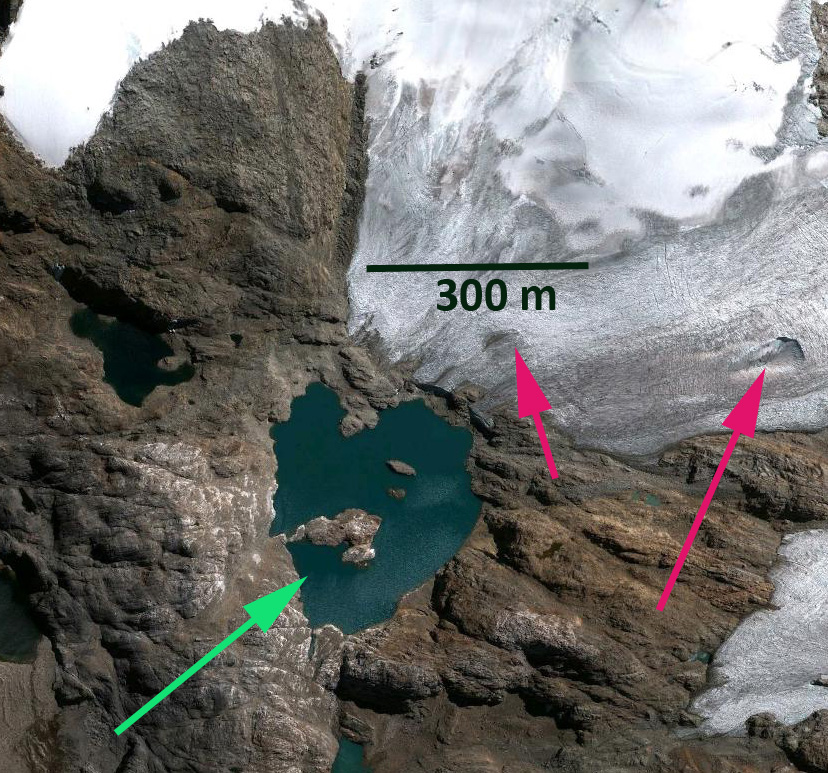October 28, 2012
Manon Glacier Retreat Lake Formation, Peru
Posted by Mauri Pelto
In the Cordillera Centrale of Peru a series of glaciers extends north from Pariacaca. Pariacaca is the pre-Incan god of water, appropriate name in this dry region, that is draped with glaciers and has numerous alpine lakes. In fact with glacier retreat the number of lakes is increasing. Here we examine the Manon Glacier which descends from Nevado Suerococha and drains into the Rio Carhuapampa.  This area has received little attention when it comes to glacier study. A glacier lake outburst flood from the Suerococha Basin in 1941 is the only noted event. The retreat of the Manon Glacier over the last decade is documented with a comparison of Landsat and Google Earth imagery from 1997, 1998, 2005,2010 and 2012. The retreat of these glaciers matches the more closely observed Cordillera Blanca and Quelcaya Ice Cap region (Mark., 2008 and Vuille et al, 2008). The Manon Glacier terminus is indicated with a green arrow in the Landsat images. The pink arrow is the Chuecon Glacier which will be the focus of a later post. In 1997 the lake at the terminus has not yet begun to form, by 2005 the lake has nearly reached its full size, and the glacier is still terminating in it. By 2010 and 2012 the glacier no longer reaches even the edge of the new lake. The retreat from 1997 to 2010 is 550 meters, the lake is 500 meters long.
This area has received little attention when it comes to glacier study. A glacier lake outburst flood from the Suerococha Basin in 1941 is the only noted event. The retreat of the Manon Glacier over the last decade is documented with a comparison of Landsat and Google Earth imagery from 1997, 1998, 2005,2010 and 2012. The retreat of these glaciers matches the more closely observed Cordillera Blanca and Quelcaya Ice Cap region (Mark., 2008 and Vuille et al, 2008). The Manon Glacier terminus is indicated with a green arrow in the Landsat images. The pink arrow is the Chuecon Glacier which will be the focus of a later post. In 1997 the lake at the terminus has not yet begun to form, by 2005 the lake has nearly reached its full size, and the glacier is still terminating in it. By 2010 and 2012 the glacier no longer reaches even the edge of the new lake. The retreat from 1997 to 2010 is 550 meters, the lake is 500 meters long. 



 The 2010 Google Earth image indicates no snow snow on the southern half of the glacier, even at its highest altitude of 5200 m, the larger section coming off the main peak has a snowline at 5100 meters. A closeup of the terminus indicates that the southern portion of the glacier also has a number of features indicative of stagnation, pink arrows. Thesse are depressions that have higher debris concentration and are wind scoured, both enhancing melting. If the debris cover was a thick blanket it could retard melting. This type of ablation hollow is also seen at the top of the southern section of the glacier, indicating this part no longer has an accumulation zone and will melt away.
The 2010 Google Earth image indicates no snow snow on the southern half of the glacier, even at its highest altitude of 5200 m, the larger section coming off the main peak has a snowline at 5100 meters. A closeup of the terminus indicates that the southern portion of the glacier also has a number of features indicative of stagnation, pink arrows. Thesse are depressions that have higher debris concentration and are wind scoured, both enhancing melting. If the debris cover was a thick blanket it could retard melting. This type of ablation hollow is also seen at the top of the southern section of the glacier, indicating this part no longer has an accumulation zone and will melt away. 



 Dean of Academic Affairs at Nichols College and Professor of Environmental Science at Nichols College in Massachusetts since 1989. Glaciologist directing the North Cascade Glacier Climate Project since 1984. This project monitors the mass balance and behavior of more glaciers than any other in North America.
Dean of Academic Affairs at Nichols College and Professor of Environmental Science at Nichols College in Massachusetts since 1989. Glaciologist directing the North Cascade Glacier Climate Project since 1984. This project monitors the mass balance and behavior of more glaciers than any other in North America.